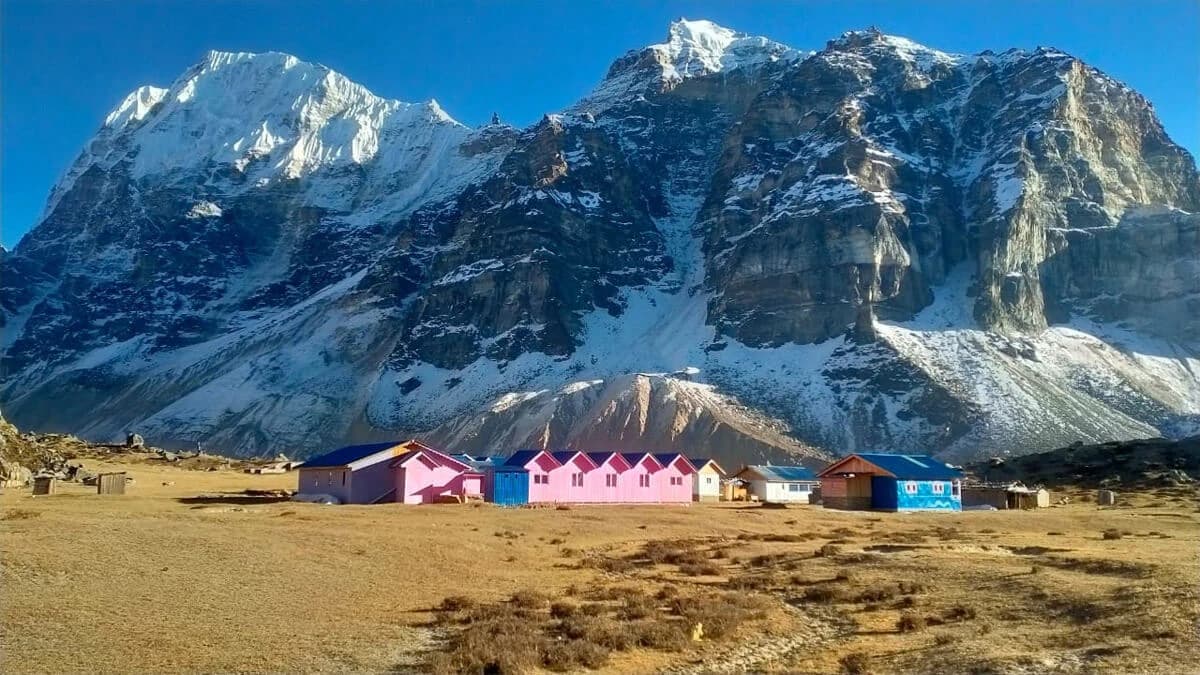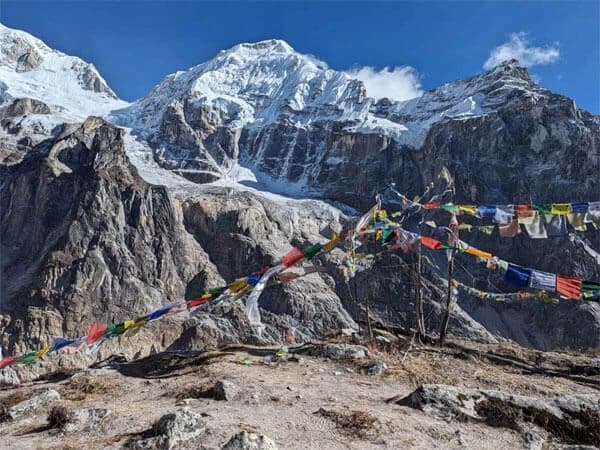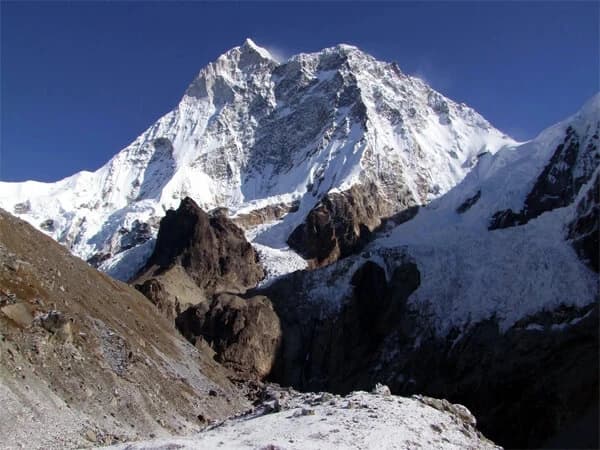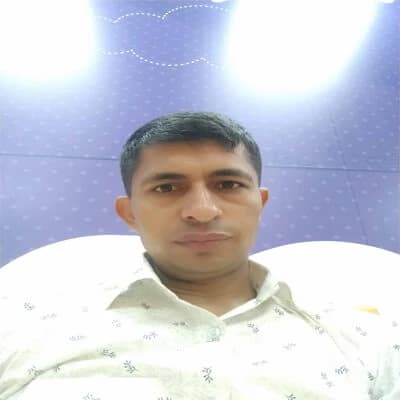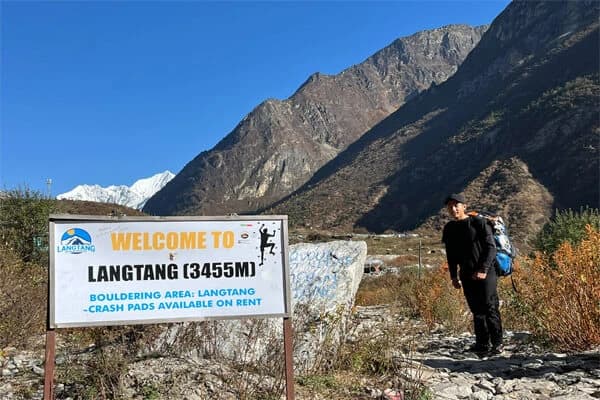Trekking in Nepal promises breathtaking adventures in hidden gems like the Kanchenjunga Circuit. It offers diverse landscapes, vibrant cultures, and unmatched Himalayan beauty. With evolving facilities, ethical trekking practices, and remote trails, Kanchenjunga is the ultimate destination for trekkers worldwide.
The Kanchenjunga Circuit trek is a thrilling adventure that takes you through the remote wilderness of Eastern Nepal. This trek offers an unparalleled experience for avid trekkers and nature enthusiasts. It encircles the world’s third-highest peak, Mount Kanchenjunga (8,586m). It is not just a physical journey but also a soulful exploration of one of the most unspoiled trekking regions of the Himalayas.
The trek is located in the Kanchenjunga Conservation Area which has diverse ecosystems. It ranges from lush subtropical jungles to alpine meadows and glacier zones. Along the way, trekkers encounter rare flora and fauna, including red pandas, snow leopards, and various rhododendron species that bloom in spring. This biodiversity hotspot remains one of the most pristine regions for Nepal Trek. It provides a serene alternative to busier trails like Everest Base Camp or Annapurna Circuit Trek.
The trek also offers a unique cultural experience. The route passes through remote villages inhabited by ethnic groups such as the Rai, Limbu, Sherpa, and Tibetan communities. These villages provide an opportunity to engage with locals observe their traditions, and experience warm Himalayan hospitality. Teahouses run by the locals offer basic yet cozy accommodations and a chance to connect over shared stories and meals.
The Kanchenjunga base camp trek is considered one of the most challenging in Nepal. Its rugged trails, steep ascents, and high-altitude crossings demand physical fitness, mental resilience, and careful planning. Proper acclimatization is crucial, as the trek reaches elevations above 5,000 meters. However, the sense of accomplishment from completing such a demanding journey is immensely rewarding.
Planning ahead for 2025/026
For 2025, the trek is significant as the region continues to gain popularity among adventure seekers looking for off-the-beaten-path experiences. Planning ahead is vital, as the restricted nature of the area requires special permits and guides. The updated information about costs, accommodations, and transportation ensures a smoother trekking experience.
The cost of the Kanchenjunga Circuit Trek can vary depending on your preferences, such as a budget-friendly or mid-range trek. Expenses include permits, guide and porter services, accommodation, meals, and transportation to and from the trailhead. Trekking independently is not allowed due to its restricted status, so hiring a guide or joining an organized trek is mandatory.
Embarking on this trek is more than just scaling heights; it’s about immersing yourself in the region where nature and culture thrive in harmony. Every step takes you closer to the beauty of unspoiled wilderness and the resilience of mountain communities. It is a once-in-a-lifetime experience that invites adventurers from around the world to explore its rugged trails and embrace its tranquil beauty. This trek is worth every effort for trekkers seeking unparalleled serenity and challenge.
Highlights of the Kanchenjunga Circuit trek

The Kanchenjunga Circuit trek is a breathtaking journey around the world’s third-highest mountain, Mount Kanchenjunga. It offers a perfect blend of natural beauty, biodiversity, and human connection. Here are the highlights of this extraordinary journey:
Panoramic Mountain views
The trek offers unparalleled views of Mount Kanchenjunga and surrounding peaks like Jannu, Tent peak, and others. The panoramic views from the North and South Base Camps are stunning. The trek showcases the sheer majesty of the Himalayas. The golden hue of these giants during sunrise and sunset is a photographer’s dream.
Kanchenjunga North and South Base Camps
Unlike most treks, the Kanchenjunga Base Camp takes you to both the North and South Base Camps. This allows trekkers to experience the mountain from different perspectives. The North Base Camp, also known as Pangpema, offers views of the Kanchenjunga Glacier. The South Base Camp provides a closer look at Yalung Glacier and surrounding peaks.
Remote and Unspoiled Wilderness
One of the trek’s greatest appeal is its remoteness. It immerses trekkers in untouched nature far from the crowded trails of Everest Region Trek and Annapurna Region Trek. The trail passes through deep valleys, rugged terrains, and high-altitude passes, offering a sense of adventure and serenity.
Kanchenjunga Conservation Area
The trek lies within the Kanchenjunga Conservation Area which is rich in biodiversity. It protects rare wildlife like red pandas, snow leopards, and a variety of birds. The region’s diverse flora includes blooming rhododendrons, orchids, and medicinal plants. It is a paradise for nature enthusiasts.
Cultural Encounters
The trail passes through the remote villages inhabited by the Rai, Limbu, Sherpa, and Tibetan origin communities. Each village offers a glimpse into the unique traditions, languages, and lifestyles of these ethnic groups. Warm hospitality, vibrant festivals, and ancient monasteries enrich the cultural experience. This creates lasting memories for trekkers.
Sele La Pass
Crossing the high-altitude Sele La Pass is one of the trek’s most exhilarating moments. The steep ascent is challenging but rewarding. It offers panoramic views of the Kanchenjunga massif and distant peaks in the Everest and Makalu ranges. The sense of accomplishment after crossing this pass is unparalleled.
Diverse Landscapes
The trek takes you through a diverse range of landscapes, from subtropical forests and terraced fields to alpine meadows and glacial terrains. Each day offers new scenery, keeping the journey exciting and inspiring.
Peace and Solitude
The remoteness of the Kanchenjunga Circuit trek offers peace and solitude. There are fewer trekkers on the trail. You can fully immerse yourself in the natural beauty and cultural richness of the region. You will have a deeply personal and rejuvenating experience.
Trekking seasons for Kanchenjunga Circuit Trek in 2025
The Kanchenjunga Circuit trek promises a unique experience for adventure seekers. However, the experience can vary significantly depending on the season Choosing the right time to trek is crucial for making the most of your adventure. In 2025, it is vital to understand the characteristics of each trekking season. This will help you plan a memorable journey based on your preferences and expectations.
Kanchenjunga circuit trek in Spring Season (March to May)
Spring is one of the most popular seasons for trekking in Nepal. It offers favorable weather and breathtaking natural beauty. The temperatures in the lower altitudes are mild, while higher altitudes stay cool. Days are sunny, with clear mornings providing stunning views of the mountains.
- Rhododendron Blooms: The hillsides along the trail are adorned with colorful blooms of rhododendrons. This creates a magical atmosphere.
- Clear views: Mornings offer unobstructed views of the Himalayas while afternoons may be hazy.
- Festivals and Culture: Trekkers may witness local celebrations like Holi and Buddha Jayanti. They add cultural depth to the experience.
Spring trails can be busy, so early bookings are recommended for accommodation and guides.
Kanchenjunga circuit trek in Summer Season (June to August)
The summer months coincide with the monsoon season in Nepal. It brings heavy rainfall and lush greenery to the trekking trails. The temperatures in the lower regions are hot, while higher altitudes stay cooler. Frequent rain showers and high humidity are characteristics of this season.
- Lush Landscapes: The monsoon transforms the hills and valleys into a vibrant green wonderland.
- Fewer Crowds: Trails are much quieter, allowing for a calmer trekking experience.
Trails can be muddy and slippery. Leeches and mosquitoes are common in lower altitudes. Proper waterproof gear is essential. It is better to be prepared for potential delays due to weather.
Kanchenjunga circuit trek in Autumn Season (September to November)
Autumn is the most popular season for Nepal trekking. Its stable weather conditions and breathtaking views make it a perfect choice to plan your trip in 2025. The days are sunny and warm in lower regions. The higher altitudes are cooler.
- Crystal-Clear Views: Autumn offers unparalleled visibility, with panoramic views of the Himalayan peaks.
- Festivals: Major Nepali festivals like Dashain and Tihar fall during this season. It adds a cultural dimension to your trek.
- Long Days: The days are longer and mild temperatures make it more comfortable to walk.
The popularity of autumn means busier trails and fully booked teahouses. Advanced planning for permits, guides, and accommodations is essential.
Kanchenjunga circuit trek in Winter Season (December to February)
Winter is the least popular season for trekking in Nepal. However, it offers unique advantages for those who can brave cold. The lower altitudes have mild temperatures while high-altitude regions can drop below freezing. Snowfall is common in higher areas, making some passes inaccessible.
- Peaceful trails: with fewer trekkers on the trails, you can enjoy solitude and uninterrupted views.
- Stunning snow-covered landscapes: The snow adds a magical touch to the scenery.
Extreme cold and snow may deter some trekkers. Proper gear, including insulated clothing and high-quality sleeping bags, is a must.
Cost for the Kanchenjunga Circuit Trek

Here is the breakdown of the cost of the trek
Kanchenjunga circuit Trekking Permits Cost
- Restricted Area Permit: $20 per week per person
- Kanchenjunga Conservation Area Permit: $30 per person
- TIMS (Trekker’s information management systems): $10 per person
Kanchenjunga circuit trek Guide and Porter Costs
- Licensed Guide: $25-$30 per day
- Porter: $18-$25 per day
- Combined guide-porter option: $30 per day
Kanchenjunga circuit trek Accommodation and Meals
- Teahouse accommodation: $5-$10 per night
- Food Cost: $25-$30 per day for three meals
Kanchenjunga circuit trek Transportation Costs
- Flights: Kathmandu to Bhadrapur ($150 one way)
- Ground transport: Bhadrapur to Taplejung by jeep ($30-$50)
Total Estimated Cost
- Budget Trek: $1200-$1500 per person
- Mid-Range Trek: $1,800-$2,200 per person with additional comforts.
Group discounts are available from our agency, Nepal Trekking Routes. You can consult with our expert for further consideration.
Kanchenjunga Circuit Trek Itinerary
For 2025/026, our agency Nepal Trekking Routes, offer customized itinerary of 19 days Kanchenjunga Circuit Trek. The extended Kanchenjunga Circuit trek itinerary generally takes 27-28 days to complete. However, we have modified the itinerary to a shorter and comfortable option. Here is the detailed itinerary for the trek:
- Arrival in Kathmandu:You will arrive in Kathmandu, capital city of Nepal. You will be transferred from Tribhuvan International Airport to your hotel. You will spend your day on trek preparation, including permit arrangements and a detailed briefing.
- Flight to Bhadrapur, and Drive to Taplejung: You will take a domestic flight to Bhadrapur, a city in southeastern Nepal. From there, a scenic drive takes you through hills, valleys, and rural villages to Taplejung. It is the starting point of your trek. You will rest at a guesthouse in Taplejung.
- Trek to Sukethum: You will begin your trek with a descent through terraced fields and quaint Limbu villages. The trail follows the Tamor river, crossing suspension bridges and winding through forested areas. You walk for 6-7 hours enjoying lush greenery and river views and reach Sukethum. You can interact with locals and learn about Limbu culture while staying at a teahouse.
- Trek to Amjilosa: The trail to Amjilosa is more challenging, with steep ascents and descents. You will pass through dense bamboo and rhododendron forests, crossing streams and enjoying the wilderness. You will encounter a diverse range of flora and fauna. It takes around 5-6 hours to reach Amjilosa. You will experience a remote and peaceful surroundings. You will stay overnight at a teahouse in Amjilosa.
- Trek to Ghunsa: From Amjilosa, you will continue your journey to Ghunsa. The trail gradually ascends, offering spectacular views of alpine meadows and snowy peaks. After walking for 5-6 hours you will reach Ghunsa. It is a picturesque Tibetan-style village that serves as a major stop on the trek. You can explore the village and visit the local monastery. You can observe traditional Tibetan culture while staying in a teahouse.
- Acclimatization day: You will spend the day acclimatizing in Ghunsa to prepare for the higher altitudes. You can take short hikes to nearby ridges or simply relax and explore the village. You can visit the local monastery and observe stunning view of snowcapped mountains of Kanchenjunga Himalayan ranges from the monastery. Alternatively, you can take a short hike towards the Yamatri Khola and a lake made by the deposits of the Yamatri Glacier. You may notice some antelopes as you are moving around in the Kanchenjunga Conservation Area.
- Trek to Kambachen: The trek becomes more rugged as you ascend toward Kambachen. You will pass through rocky terrain, crossing moraines and streams. You will have magnificent views of Mt. Jannu and surrounding peaks. You will walk for 6-7 hours through remote and beautiful landscapes and reach Kambachen. You will stay at a teahouse and rest overnight.
- Trek to Lhonak: You will continue to follow the trail along the glacial moraine to Lhonak. It is a small settlement with breathtaking views of Kanchenjunga and surrounding peaks. It takes around 6-7 hours of walking through breathtaking high-latitude landscapes to reach the destination. You will stay overnight at a teahouse in Lhonak.
- Trek to Pangpema: You will have a challenging day of trekking to Pangpema, the North Base Camp of Kanchenjunga. This is the closest point to the Kanchenjunga’s North face. You can have the breathtaking views of the snow-capped mountains. You can enjoy the unmatched views of Mt. Kanchenjunga, Table Shikhar, Gimmigela Chuli, Pyramid Peak and Kirant chuli. The glacial landscapes and alpine serenity are highlights of this leg. You will walk for about 7-8 hours round trip. You will rest at a teahouse in Lhonak.
- Return to Ghunsa: You will retrace your steps to Ghunsa, descending through familiar trails. This is a relatively easier day compared to the high-altitude trek days. After walking for about 6-7 hours, you will reach Ghunsa. You can rest and relax at a teahouse after intense trekking.
- Trek to Sele La: You will climb towards the Sele La Pass. It is a challenging yet rewarding section of the trek. It offers dramatic views of the surrounding mountains, alpine landscapes and a sense of accomplishment. It takes around 5-6 hours to reach Sele La.
- Cross Sele La and trek to Tseram via Sinion La: You will cross the Sele La and Sinion La passes. Walking past the thick Himalayan forests, you will come across the main trail of Kanchenjunga South Base Camp. You should cross Lapsang La Pass to reach the South base camp of Kanchenjunga. You will enjoy the spectacular vistas of high peaks and glaciers.
- Trek to Tortong: You will descend through forested trails, passing waterfalls and streams. The gradual descent offers relief from previous challenging days. You will walk for 5-6 hours enjoying the scenic beauty of forests and river valleys to reach Tortong. It is a peaceful stop nestled amidst lush greenery.
- Trek to Yamphudin: You will continue descending to Yamphudin. You will walk along the Amji Khola banks and cross the Lassiya Bhanjyang to reach Yamphudin. It is a large settlement where you can experience the hospitality of the local communities. You will have interaction with locals and insight into traditional lifestyles. You will stay at a teahouse in Yamphudin.
- Trek to Pumphe Danda: You will gradually descent to Pumphe danda through forests and terraced fields. This day offers a mix of cultural and natural experiences. After walking for 5-6 hours, you will reach Pumphe danda. You will enjoy the serene landscapes and interaction with locals.
- Trek to Kunjari: You will continue your trek by ascending towards a higher ridge and descending towards Yangpang. Then pass through river banks and waterfalls to reach Kunjari.
- Trek to Suketar: You will move towards Suketar passing through gushing rivers, serene villages, terraced fields and lush forests. You will stay at a teahouse in Suketar for night rest.
- Fly back to Kathmandu: You will catch a flight from Suketar to Kathmandu. You will check in to the hotel and have a stroll around the Thamel Bazaar. You will have a dinner with our company.
- Onward Departure: This could be a final day of your journey. Alternatively, you can extend your stay and take a trip another in an exciting destination in Nepal. We have a wide range of activities including trekking, short hikes, day tours and multi day tours that can fit in your schedule and preferences.
Additional Considerations for Kanchenjunga Circuit Trek in 2025
Trekking Group sizes
Solo Trekkers:
Trekking solo is possible but not advisable due to the remoteness and the restricted area regulations, which requires at least two trekkers and a guide. It can be expensive to trek solo if you hire a guide and a porter.
- Solution for Solo Travelers: Join an organized trekking group or find trekking partners through agencies to comply with permit requirements and share costs.
Group Trekkers:
In 2025, trekking in a group will remain a popular option, especially for remote treks like the Kanchenjunga Circuit. Group trek offer a balance of shared costs, camaraderie, and enhanced safety.
Group size: 4-8 people to minimize the environmental impact while maintaining a sense of community.
Environmental and Ethical Trekking
Environmental Impact:
The Kanchenjunga region is pristine and protected. It is crucial for trekkers to adhere to Leave No Trace principles. It is vital to minimize the environmental impact in 2025.
- Pack reusable items: Water bottles, utensils and eco-friendly toiletries.
- Avoid plastic: Bring purification tablets or filter for water instead of buying bottled water.
Supporting Local Communities:
- The trek passes through small villages where tourism plays a vital role in livelihoods.
- Opt for teahouse accommodations and locally sourced meals.
- Purchase handicrafts or snacks from local vendors to support the local economy.
Health and Safety Precautions
Altitude Sickness Awareness:
The Kanchenjunga Circuit reaches heights above 5,000m increasing the risk of altitude sickness. Acclimatization is essential to prevent the symptoms of altitude sickness. In 2025/026, our agency will continue to emphasize on gradual ascents and rest days.
The symptoms of altitude sickness are headache, nausea, dizziness, or difficulty breathing. You should stay hydrated and stop ascending if symptoms appear.
Remote Trail Challenges:
The Kanchenjunga Circuit is less developed compared to popular trekking routes like Everest Gokyo Lake Trek or Annapurna Base Camp Trek. The medical facilities are limited. You should carry a comprehensive first-aid kit. You can use satellite phones or a reliable guide for emergency contact.
Physical Fitness:
This trek is categorized as strenuous, requiring trekkers to prepare physically in advance. You should start fitness training 2-3 months before your trek. Focus on cardiovascular training, strength building exercises, and practice hikes to improve stamina and reduce injury risk.
- Cardiovascular Exercise: It helps to build muscles and endurance. Examples: running, walking, jogging, cycling, swimming etc.
- Strength Training: It helps to strengthen leg and core muscles. Examples: squats, crunches, lunges, planks etc.
- Practice Hiking: Practice hiking with loaded backpack to simulate the trekking conditions.
Cultural Sensitivity
Unique Cultures of Kanchenjunga:

The region is home to the Limbu, Rai, Sherpa, and Tibetan communities. You should respect their traditions and way of life. You can learn a few greetings and simple phrases in Nepali or local dialects. You should dress modestly by covering shoulders and knees, especially in villages and monasteries.
Photography:
You should seek permission before taking photos of people or religious sites. It shows respect for their privacy and beliefs.
Trekking Tips for 2025/026
Trekking in2025/026 requires careful planning, environmental responsibility, and adaptability to changing conditions. Here are some key tips:
- Plan Ahead: You should research your trekking route thoroughly, including permits, weather conditions, and accommodation options.
- Pack Smart: You should carry essential gear, including layered clothing, trekking poles, and water purification. Lightweight, reusable items reduce waste and make your trek eco-friendly.
- Hire local Guides: You should support local economies by hiring certified guides and porters. They provide safety, cultural insights, and navigation in remote regions.
- Acclimatize properly: You can prevent altitude sickness by trekking slowly, staying hydrated, and taking rest days. You should listen to your body and learn the symptoms.
- Respect Nature and Culture: You should follow Leave No Trace principles. Avoid single-use plastics, respect wildlife, and dress modestly in villages and religious sites.
- Stay flexible: You should stay flexible because weather patterns are becoming less predictable due to climate change. Prepare for sudden rain, snow, or trail closures.
- Train Beforehand: You should build endurance with cardio and practice hikes to ensure you are physically ready for long ascents and challenging terrains.
Conclusion:
The Kanchenjunga Circuit Trek is an unmatched adventure for the trekkers seeking an experience beyond the ordinary. It is a journey into the heart of the Himalayas, where each step reveals a new facet of beauty and wonder. It is a must have on your bucket list adventure for 2025. Budgeting and proper planning is important for a safe and enjoyable trek.
Our agency Nepal Trekking Routes has a team of experts and professional guides who have years of experience. We offer customized itineraries based on your budget and preference. Explore the Kanchenjunga Circuit, a remote gem of Nepal for unparalleled beauty and serenity.

